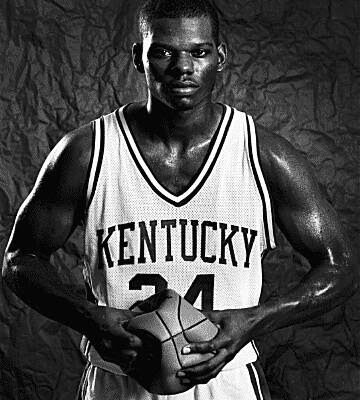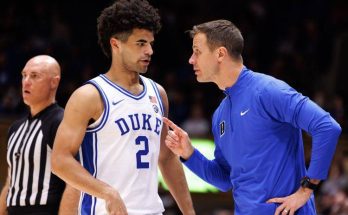On the anniversary of Kentucky’s 1993 Final Four run, the university will unveil a 12-foot statue of Jamal Mashburn outside Rupp Arena, honoring the Wildcats legend who helped spark a new era of excellence in Kentucky basketball history.
On the anniversary of Kentucky’s memorable 1993 Final Four appearance, the University of Kentucky will honor one of its most iconic players in a way that’s both fitting and monumental—by unveiling a 12-foot statue of Jamal Mashburn outside Rupp Arena. This tribute is more than just bronze and steel. It’s a permanent reminder of a player who didn’t just play for Kentucky but helped redefine what Kentucky basketball could be in the modern era.
For a program as historic and tradition-rich as Kentucky’s, honoring players comes with a high bar. The Wildcats don’t just celebrate great seasons or impressive stat lines—they celebrate legends. And Jamal Mashburn, often referred to by fans as “The Monster Mash,” is exactly that. He wasn’t just a scorer, though his offensive firepower was undeniable. He wasn’t just a leader, though his calm, confident presence steadied a team still healing from the scars of scandal and sanctions. He was, simply put, the face of Kentucky’s basketball rebirth in the early 1990s.
In many ways, the decision to erect a statue of Mashburn is long overdue. When Rick Pitino took over the Kentucky program in the late 1980s, the Wildcats were reeling from NCAA violations and probation. Pitino needed a star, a foundational piece to build around, someone who could shoulder the burden of expectations and elevate everyone around him. He found that player in Jamal Mashburn. A gifted forward from the Bronx, Mashburn brought swagger, skill, and a work ethic that made him a perfect fit for Pitino’s up-tempo, aggressive system.
From the moment he stepped onto the floor in Lexington, Mashburn made an impact. He wasn’t just good—he was electric. A versatile scorer who could shoot from deep, attack the basket, and post up smaller defenders, Mashburn had a modern NBA game long before it became the norm in college basketball. More importantly, he brought a confidence to the program that had been missing. Kentucky fans didn’t just believe in their team again—they believed in their star. And Mashburn delivered.
His junior season in 1992–93 remains one of the most cherished in Kentucky lore. That year, the Wildcats finished 30–4 and reached the Final Four for the first time since 1984. Mashburn was the driving force behind it all, averaging over 20 points per game and delivering clutch performances time and time again. His leadership, both on and off the court, helped unite a roster filled with talent, from Travis Ford and Tony Delk to Walter McCarty and Rodney Dent. Together, they formed one of the most exciting teams in college basketball—fast, fearless, and fun to watch.
The highlight of that magical run came in the NCAA Tournament. Kentucky bulldozed its way through the early rounds before running into the Fab Five of Michigan in the national semifinals. Though the Wildcats fell just short in a heart-wrenching overtime loss, Mashburn’s performance and presence on the national stage helped solidify Kentucky’s return to prominence. The loss hurt, but it also proved something critical—the Wildcats were back. And Mashburn had led them there.
In the years since, the legacy of that 1993 team has only grown. It set the stage for Kentucky’s eventual 1996 national championship, a title won by players who had been inspired and motivated by what Mashburn and his teammates accomplished. His influence is still felt in Lexington to this day, not just in banners or highlights, but in the culture of excellence he helped restore. For fans who lived through the darker years of probation and struggle, Mashburn represented hope. For younger generations, he’s a mythic figure, the player who lit the fuse that launched Kentucky back to national dominance.
A statue, then, is not just a tribute to his stats or accolades—it’s a symbol of that transformation. Standing 12 feet tall, the monument will greet fans as they enter Rupp Arena, a daily reminder of what one player can mean to a program. It’s not just about honoring Mashburn the player, but Mashburn the leader, the catalyst, the icon. His jersey has long hung in the rafters, retired among the greats. But this statue takes that reverence a step further. It places him alongside the giants of the game, quite literally.
The decision to unveil the statue on the anniversary of the 1993 Final Four run adds a poetic layer to the moment. It connects past and present, reminding fans not only of where the program has been but how far it has come. As current players walk past Mashburn’s statue on their way into Rupp Arena, they’ll be reminded of the standard that was set before them. They’ll see not just a player frozen in bronze, but a legacy carved into Kentucky’s DNA.
Mashburn’s impact didn’t end when he left Kentucky. After declaring for the NBA Draft in 1993, he was selected fourth overall by the Dallas Mavericks. His professional career, which spanned over a decade, was filled with highlights. He averaged over 19 points per game during his time in the league and made an All-Star appearance in 2003. Yet despite his NBA success, Mashburn has always remained closely tied to Kentucky. He never forgot where it started, and the fans never forgot him. His post-basketball life has included successful business ventures and broadcasting, but he has always been embraced by the Big Blue Nation as one of their own.
In many ways, that’s the beauty of college basketball at a place like Kentucky. The bond between player and program is deep, enduring, and heartfelt. Fans don’t just cheer for the name on the jersey—they invest in the story behind the name. And Mashburn’s story is one of loyalty, leadership, and legacy. He came to Kentucky at a time when few others dared. He stayed when he could have left. He delivered when the program needed him most.
Now, with a 12-foot statue standing proudly outside one of the sport’s most iconic arenas, that story becomes part of the physical landscape. It becomes a place for reflection, celebration, and connection. Young fans who never saw Mashburn play will ask about him. Parents will tell stories. Alumni will point with pride. And Jamal Mashburn’s legacy will live on—not just in highlights and memories, but in stone and steel, forever watching over the program he helped resurrect.
This honor is not just deserved—it’s essential. Because every great program has turning points. Moments that change its direction. Players who redefine its identity. Jamal Mashburn was that player for Kentucky. He was the bridge from scandal to success, from uncertainty to glory. His statue will stand not just as a tribute to the past but as a beacon for the future—a constant reminder that greatness isn’t given, it’s earned. And Jamal Mashburn earned every inch of that 12-foot legacy.



